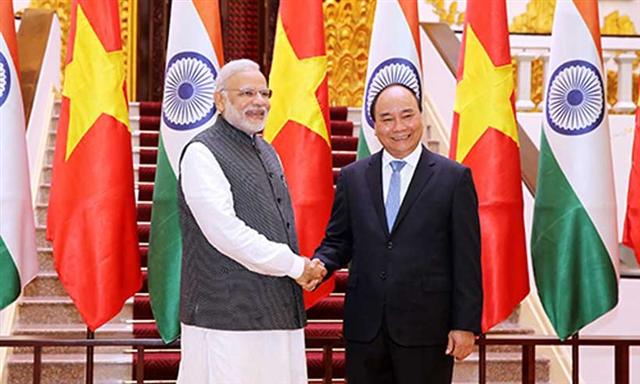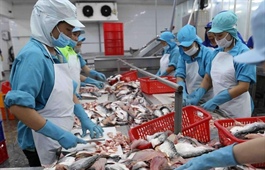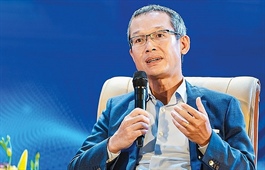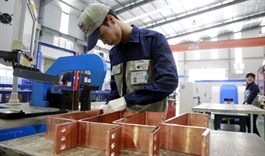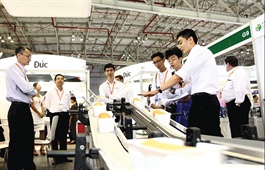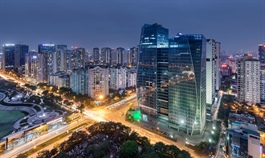India favors closer cooperation with Vietnam
India favors closer cooperation with Vietnam
India is currently reviewing the terms in the Free Trade Agreement (FTA) with ASEAN, seeking more equality, and rejecting grounds that are not in its favor.
Illustrative photo.
|
However, India has also left a wide open corridor for more commercial cooperation with Vietnam under an equal bilateral framework. Hence, this is an opportunity for Vietnam to seek advantages in this huge market of almost 1.3 billion people.
India reviewing FTA
Speaking at a recent trade conference in Hanoi, Mr. Pranay Verma, Ambassador of India to Vietnam, emphasized the importance of Vietnam as a vital trade partner of India. Vietnam is considered like a gateway for India to access the larger ASEAN market. The Ambassador also expressed his wish to see India develop into an economy worth USD 5,000 bn, thereby becoming the fourth largest economy in the world in the next five years. This development will be realized under a visionary scheme of the present Prime Minister of India, Mr. Narendra Modi, who wants to see a self-reliant India under a plan termed "AatmaNirbhar Bharat Abhiyaan”. The Ambassador also spoke about India reviewing the terms of the FTA with ASEAN, with an emphasis on more equality, while at the same time, leaving open the possibility for Vietnam-India trade to be prioritized under a bilateral cooperation framework.
In recent years, India has been reviewing and is reconsidering the continuation of FTA with ASEAN. The Indian Minister of Industry and Trade has even asked to renegotiate a number of articles under the agreement, but so far ASEAN has refused the suggestion. The total value of India's trade with ASEAN countries reached about USD 87 bn in the period 2019 to 2020, of which exports alone accounted for USD 32 bn and imports amounted to USD 55 bn. India's trade deficit with ASEAN countries stands at USD 23 bn. India is also currently under heavy deficit with many other partners, such as China. Therefore, adjusting and limiting the trade deficit will be a top priority in trade cooperation for the Indian government today. This shows that along with strengthening its economy, India is taking a tougher stance in global trade activities.
Currently, under India-ASEAN FTA terms, Vietnam must remove 80% of tariff lines within this year from the normal tariff reduction list, and 10% of tariff lines by 2024 in the sensitive list. By 2024, Vietnam will have to complete a schedule of commitments to reduce tariffs focused on commodity groups such as tea, coffee, rubber, vegetables, footwear, seafood, chemicals, metals, steel, minerals, machinery, equipment and construction materials. Products that Vietnam does not commit to include eggs, sugar, salt, petroleum, fertilizers, plastics, rubber, precious metals, steel, machinery, electrical equipment, automotive machinery, spare parts, and security items.
On the Indian side, so far India has eliminated 80% of the tariff lines, while 10% of the tariff lines have been partially cut. The goods that India commits to tariff elimination include live animals, meat, fish, milk, vegetables, grease, confectionery, fruit juices, chemicals, cosmetics, textiles, metals, steel, machinery, electrical equipment, and clocks. Under the commitment to cut taxes from India, many categories of Vietnamese goods will benefit such as garments, footwear, wood and wood products, seafood, coal, rubber, and steel. In 2018, India agreed to reduce taxes to 45% on coffee, black tea, and 50% on pepper. These are sensitive Indian products but are an export advantage for Vietnam. India's exclusion list includes 489 tariff lines, accounting for 5% of the total trade value.
Mekong-India economic corridor
Currently, Vietnam is the 17th largest partner of India and 4th in Southeast Asia. According to data from the Ministry of Planning and Investment, India's investments in Vietnam are estimated at USD 1.9 bn. Regarding investments in India, Vietnam has six projects with total investment capital estimated at USD 28.55 mn, mainly in the fields of pharmaceuticals, information technology, chemicals, and construction materials.
However, India wants to see stronger prospects of cooperation with Vietnam, and not just through trading and investing in projects. New Delhi also wants to have a closer connection and ties, such as by building the Mekong-India economic corridor, a multimodal economic corridor connecting India with the Mekong sub-regional countries. The Mekong-India Economic Corridor proposes to connect Ho Chi Minh City with Dawei in Myanmar via Bangkok in Thailand and Phnom Penh in Cambodia, and onto Chennai in India. This economic corridor will help increase trade between the CLMV countries, namely, Cambodia, Laos, Myanmar, and Vietnam, and with the rest of the world, as well as India. It will also substantially reduce travel distance between India and the Mekong sub-region.
The Mekong sub-region plays an important role in the foreign policy of India, as it shares a land boundary with one of the CLMV countries, namely, Myanmar in the Bay of Bengal. On the other hand, with China growing as an important economic power, the countries in the Mekong sub-region are gradually being attracted towards China, to further strengthen their economies. China's growing influence in the region has prompted India to strengthen ties with countries under ASEAN by taking a number of measures to promote integration with the Southeast Asian region.
The India-Mekong economic corridor will certainly create opportunities for countries in the region for building a strong economic and industrial infrastructure and also for upgrading the existing infrastructure. The Mekong-India Economic Corridor will allow countries in the Mekong sub-region, including Vietnam, to integrate better and to have a globally competitive economy. In this respect, India chooses well to have Vietnam as an important trade partner.


